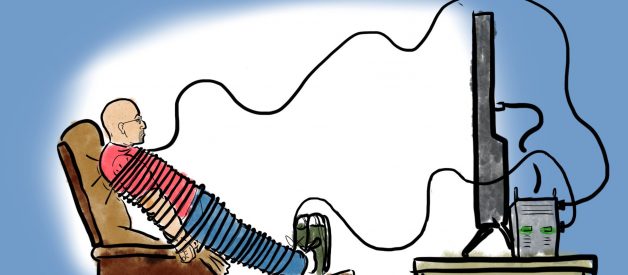It?s time for cable companies to unbundle Internet, TV, and Phone and give us the service we want

Isn?t cord-cutting awesome? All you need is a broadband Internet connection and you can enjoy Internet access and streaming TV content from the set-top box of your choice.
Among those offering Internet plans to the cable-free set is Spectrum, which is owned by Charter Communications, the company that gobbled up Time Warner Cable and Bright House. For just $19.99 a month you can get something called Spectrum Internet Assist. It promises 30 Mbps download speeds and doesn?t saddle you with Cable TV or the bill that comes with it.
That?s the fantasy. Here?s the reality.
As I prepared to move my daughter and her girlfriend into their first off-campus apartment, losing some of the built-in dorm perks like a quick walk to class and ubiquitous broadband Wi-Fi, we went in search of affordable Internet. She?d need it for email, accessing syllabi, managing her curriculum, and entertainment.
Who needs cable?
Like most millennials, my daughter almost never watches anything, save The Bachelor, on broadcast TV. She?s devoted to a collection of streaming apps, Hulu, HBO Go, and Netflix, all installed on her Amazon Fire TV. She didn?t need cable, she didn?t need phone service, she didn?t need to shop for a so-called Triple-Play deal.
In upstate New York, where my daughter attends school, there are around a half-dozen cable provider options, Spectrum is invariably the cheapest. It?s also the only one offering an Internet-only option.
The Spectrum.com site offers a dizzying array of service options, many with lengthy, confusing, and somewhat hidden ?Product offer and disclaimers.? However, I found the deal I was looking for: Internet Assist for $19.99 a month (Spectrum occasionally runs a $14.99-a-month special). It promised:
- High-speed 30 Mbps Internet
- PLUS: FREE antivirus with Security Suite
- FREE Internet modem and no data caps or extra fees
The disclaimer, which I found hidden under a link at the bottom of the page didn?t offer much more detail beyond informing me that upload speeds would be relatively slow:
?Spectrum Internet Assist. $14.99/mo. Limited Time offer; subject to change. Internet download speeds are up to 30 Mbps and upload speeds are up to 4 Mbps. Available Internet speeds may vary by address.?
I chose the Spectrum Internet Assist Plan option and, after entering a few more contact details, was informed that a customer service rep would be calling me to complete the transaction.
A moment later my cellphone rang. It was Kalvin, the Spectrum customer service rep. We quickly walked through the details of the Spectrum Internet Assist Deal. As promised, there?d be no charge for installation, the Wi-Fi router, or modem and the deal locked in the price for 12 months. After that, it could go up. That was fine by me since my daughter didn?t plan on living there more than nine months. She could also cancel the service without penalties.
I asked Kalvin if this plan would be sufficient to stream Netflix. ?Absolutely,? he told me. I also asked if Kalvin needed my credit card info or any other information, but he explained that the first bill would be snail-mailed to her apartment and she could set up her payment method through that form.
After I hung up, we got a confirmation email detailing her order. I smiled as I saw all the fees Spectrum was deferring for this deal. Normally installation would?ve cost almost $100. Instead, the only listed charges were $5.00 a month for Spectrum Wi-Fi and $14.99 a month for Spectrum Internet Assist.
We scheduled the Spectrum installation guy to arrive on move-in day.
A good start
First, I got a robo-call telling me the guy was en route and that installation could take three hours. Sean the installation guy arrived promptly at 2 PM and after spending 30 minutes installing a router and modem and then testing the connection, Sean informed me he was done. He handed me his card and my daughter a slip of paper with SSIDs and passwords for the new 2G and 5G Wi-Fi networks. Sean told me to call if there were any problems.
There were four of us in the apartment moving boxes and building furniture. We all started switching our phones over to the Wi-Fi network. My iPhone X quickly opened one Website after another.
I was feeling pretty good about myself. With Internet installed, I could set up her TV, FireTV, Google Home Mini, her laptop, printer, and anything else that needed Internet and Wi-Fi access.
While I worked on the TV, I had my daughter set-up the Google Home Mini.
At first, things went smoothly. I powered up the TV and FireTV, put the latter on the 5G network and downloaded Netflix. I looked over at my daughter who was staring at her phone. I asked her what was wrong, and she said it was taking a little while to get the app. I figured she was being impatient and turned my attention back to Netflix.
After signing into our account, I accessed her profile and pulled up the Friends feed. I selected an episode and hit play.
Netflix?s little red loading circle began to spin. ?4%?.8%?..9%?.11%? My eyes grew wider as I watched the network struggle to build the stream. ?That?s not good,? my daughter observed.
Finally, the feed hit 100% and Friends started to play. Ross and Rachel were blockier than a pair of Minecraft characters.
In the meantime, my daughter was trying to train Google Mini on her voice. You do this through the app, which is connected to Spectrum Wi-Fi and then to the Internet and then back to the Mini. She kept repeating ?OK, Google,? but it wouldn?t work.
I checked my phone to see what was up with the Internet, but it was off the network.
When I looked back up at the TV, the Amazon Fire TV informed me that it, too, was off the Internet.
I had a feeling the network didn?t like so many people and IoT devices connected to it. I unplugged the Google Mini, asked everyone to take their phones off the Wi-Fi network and went back to the FireTV. It got back online, but the connection was still thready.
Not what you wanted
I called Sean who informed me that he?d heard similar complaints from other Spectrum Internet Assist customers. As far as he could tell, the service was only good if you lived alone and used one Internet-connected device at a time.
In other words, it was a great price for a garbage service.
The good news, Sean continued cheerfully, was that he had installed the high-end router and modem equipment and that, if we upgraded our service, the equipment could handle it.
In a mini panic, my daughter got on her phone, navigated to the Spectrum.net site and started looking into faster and more reliable Internet options.
The next best deal was for 200 Mbps Internet plus a Cable TV bundle she didn?t want or need for $49 a month plus another $6 or so for a cable box she didn?t want. Spectrum, like virtually every other Internet provider in the nation, offers no step-up between crappy Internet and useable Internet. If you want the latter, you have to accept their cable TV service, too.
Before I could investigate further, my daughter signed off on the upgrade.
An email with the subject line ?Spectrum Order ? Agreement Information? arrived. My daughter looked at it incredulously. ?What the hell is this??
She handed me her phone and I scrolled through a literally 10,389-word agreement. In all of it was no mention of her specific service or the update she?d requested. It was boilerplate, cover-your-ass legalese.
An hour later another email arrived. This one confirmed the service upgrade, but when my daughter saw her new monthly bill, she blanched. The monthly fee was $66, not the $56 she thought she?d agreed to, and with taxes and other fees, the new grand total was $78.39.
Stunned, she logged back onto the Spectrum website to figure out what happened. Unfortunately, Spectrum wouldn?t show her an itemized bill before she verified her account, which she could only do with either the last four digits of the credit card she used to pay her bill (she had yet to make a first payment) or the security code from her first bill, which she had yet to receive.
Worst of all, the service was still unchanged. We decided to leave it for the day and check the service again when we returned the next day to finish moving her in.
Fixed?for a price
As soon as I got back to the apartment that next morning, I turned on the TV, powered up the FireTV and logged into Netflix. I selected Friends and it loaded instantly. The picture looked great. As it played, I put my phone on the network, then added the Google Home Mini. Everything connected. Web pages loaded in a flash.
The service was good, but I still wasn?t happy.
As of this moment, I have no idea how Spectrum got from $56 a month to $78. In addition, Spectrum Assist was a bait and switch and I think I know why.
Cable company revenues from channel subscription fees are dwindling, as is the money they make from selling multi-channel bundles. Consumers increasingly want a la carte experiences and are starting to circumvent cable company deals by paying broadcast and cable channel companies like CBS and HBO directly and accessing shows through apps installed on set top boxes connected to the Internet.
Even as the weight of the business slowly shifts from cable subscriptions to Internet access, Cable companies hold the line by forcing consumers to buy services more and more of them don?t want. If they can?t get them with Triple-Play deals, companies like Spectrum tease consumers with excellent deals on what they really want: Internet access, but they hold back the usable services (decent speeds that can support more than one user at a time) for bundles that wrap in more expensive cable and phone services many of us no longer need.
It?s obviously a broken system, so perhaps pointing a finger at Spectrum is unfair. On the other hand, Spectrum isn?t doing consumers any favors in the areas of information and transparency. Once Spectrum hooks you, it does all it can to make sure you get tangled up in its lines, unable or no longer having the will to mount an escape.
My daughter?s happy with her 200 Mbps internet, but nobody is happy about paying $78 a month for services we don?t want or need.
Cords aren?t being cut, they?re being wrapped around our wallets by cable companies, squeezing us for every last dime they can get before the cable-bundle gravy train finally comes to a stop.


